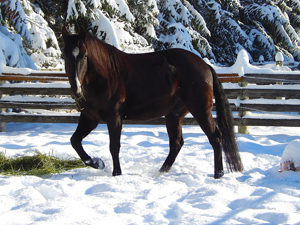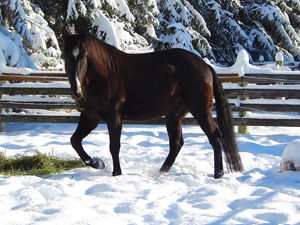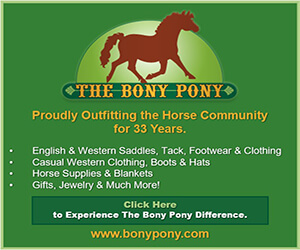Hooves Change with Seasons
by Tab Pigg

Seasonal weather changes have a major effect on horses’ hooves. Hooves change with the weather and may require extra attention and treatment. Ignoring environmental impact on hooves can lead to sole deterioration or other harmful consequences. When it comes to a horse’s environment, there are two main seasonal factors that impact hoof health: temperature and moisture.
Temperature Impacts the Hoof Cavity
Weather impacts how fast a hoof grows. Cooler temperatures cause hoof growth to slow down resulting in less frequent trimming. Warmer temperatures allow for normal sole development, and the hoof will return to its normal growth speed resulting in a need for more consistent trimming and maintenance.
It’s important for hoof-care professionals to consistently monitor growth to determine how often hooves should be trimmed or simply maintained. During periods of slow growth, it’s also vital to make sure that the hooves aren’t wearing away. Extra support inside the hoof cavity can alleviate pressure from the hoof wall to mitigate any wear that may occur.
Managing Hooves in Wet and Dry Conditions
Ground moisture is one of the most important environmental factors to consider for hoof health. Wet conditions increase the chance of infection because of the increase of moisture.
Throughout spring, some parts of the country are still getting rain and the wet environment can cause thrush to run rampant through the barn. Thrush is a bacterial infection that lives in the soft tissue of the frog and can cause irritation in a horse’s foot. Similar to athlete’s foot in humans, thrush is not life-threatening, but it can lead to serious hoof issues if left untreated.
The foot of a horse is like a sponge and can become soft and saturated when the ground is wet. In these conditions the feet often expand and become softer, so it’s important for a hoof care professional to monitor the hooves to assure that horseshoes fit correctly and that the feet are being cleaned out regularly.
To avoid infection or injury, horse owners can use pour-in pad materials to help maintain optimal sole health. Vettec’s Equi-Pak CS will bond to the bottom of a horse’s foot, sealing out moisture and preventing debris from being packed in the foot. Equi-Pak CS is a fast-setting, soft instant pad material infused with copper sulfate to effectively manage mild and moderate cases of thrush.
Another situation to consider is when a horse goes from wet to dry conditions in a short amount of time, which is likely in some areas as winter turns to spring. This can cause chipping and cracking, as well as a change in shoe size. The feet shrink as they dry out, so if a horse is shod, the shoes become too big. It’s critical that a farrier examines the hooves when this change occurs so that the horse has proper support, and to mitigate the possibility of abscesses due to cracking and chipping that may occur as the sole dries out.
When horseshoes don’t fit correctly, horses distribute their weight unevenly and land on their feet differently. If they put excessive force and stress on one area of the hoof wall, it can cause a vertical crack, otherwise known as a quarter crack. Often, a horse is in pain when it has quarter crack, and it can become lame if the condition is not treated. If a horse is diagnosed with quarter crack, it’s important to apply support to its hooves. Pour-in pads are an ideal solution to provide extra support during seasonal transitions.
Vettec Equi-Pak works well for this issue to support the internal hoof cavity. It absorbs shock and concussion to alleviate pressure from the hoof wall. Sole-Guard is beneficial and serves as a firmer pad material that distributes a horse’s weight across the entire hoof-bottom. In situations where a horse needs to relieve pressure around a quarter crack, this material is key to providing the horse relief, especially in the changing seasons.
Although moderately warm and dry weather is ideal for horses, it is common that horse owners will have to deal with a variety of climates. The temperature and moisture directly impact the anatomy and health of hooves. To maintain a horse’s overall health, it is important for horse owners to offer extra attention to soles throughout the changing seasons.
Talk with your farrier or veterinarian about your horse’s environment, and how pour-in pad materials can be a helpful tool for soles during a variety of environmental conditions.
Originally Published May 2017 Issue
Tab Pigg is a Certified Journeyman Farrier and Farrier-at-Large for Vettec Inc., a manufacturer of innovative sole support products for horses. In his role at Vettec, Tab leads hands-on clinics throughout the U.S. to teach shoeing and forging techniques to equine owners, farriers, and veterinarians. He also visits veterinary and farrier schools exchanging information about hoof anatomy and shoeing. Tab shares his expertise via a popular video and blog series,“Two Minutes with Tab” on Vettec.com For Tab, shoeing horses is much more than a way to earn a paycheck. Helping horses and knowing that he has the ability to improve the horse’s quality of life is very valuable to him. Tab lives his own motto every day: “The education to become a farrier never ends. Anyone who feels that they have it all figured out is wrong.”





